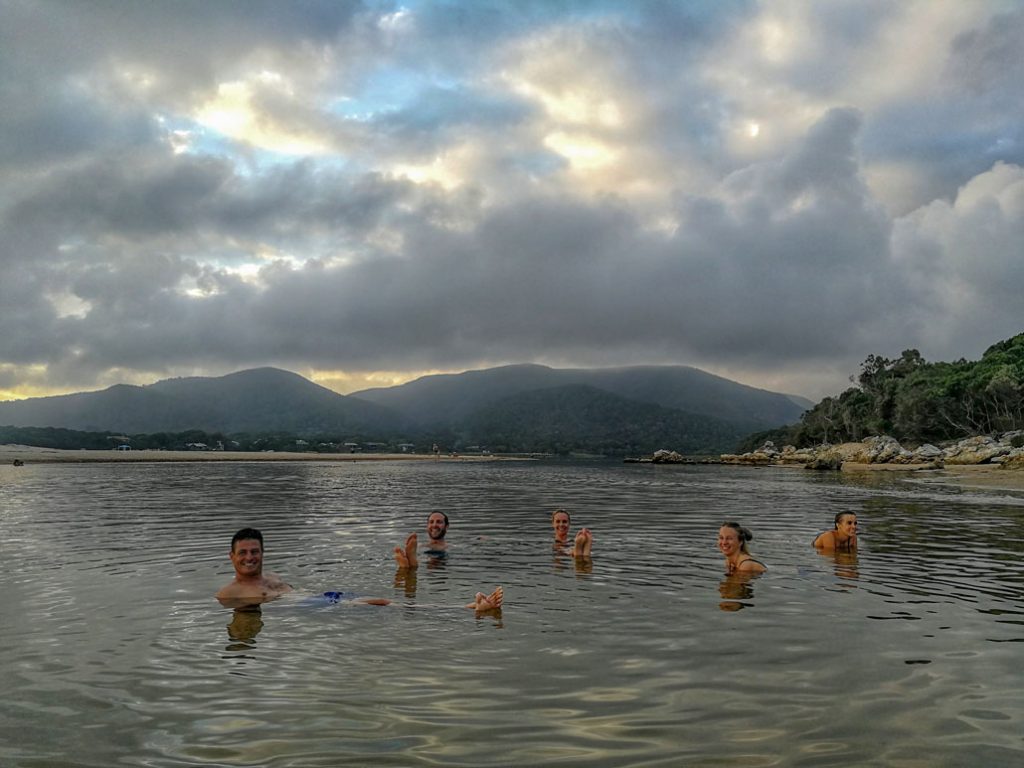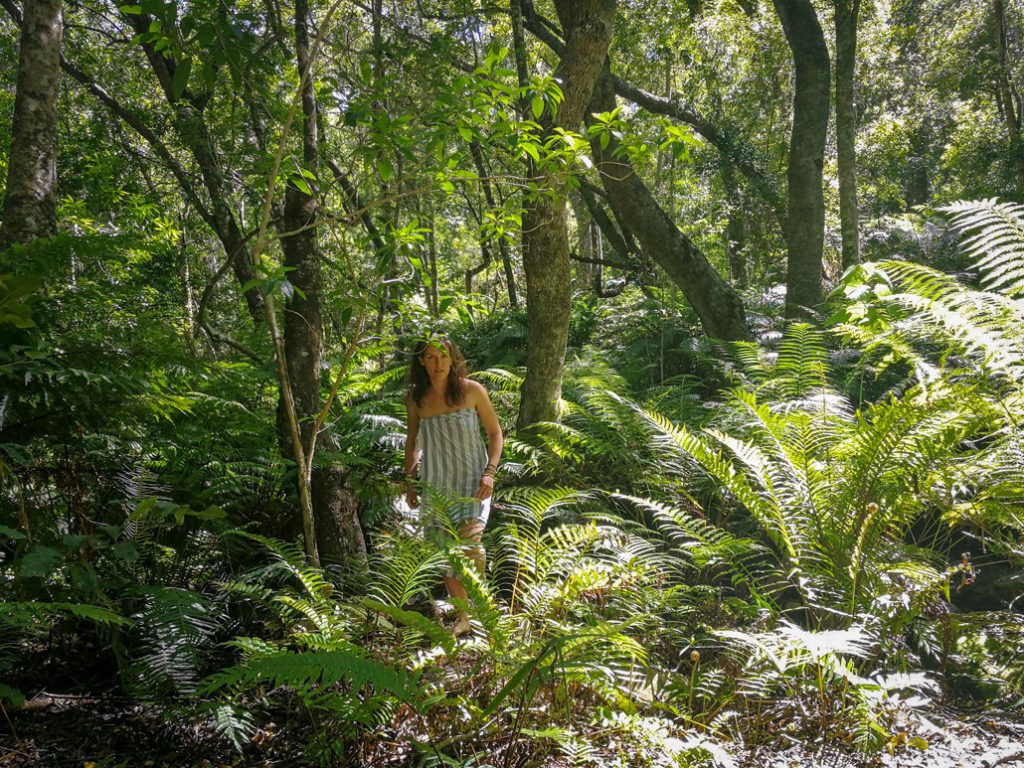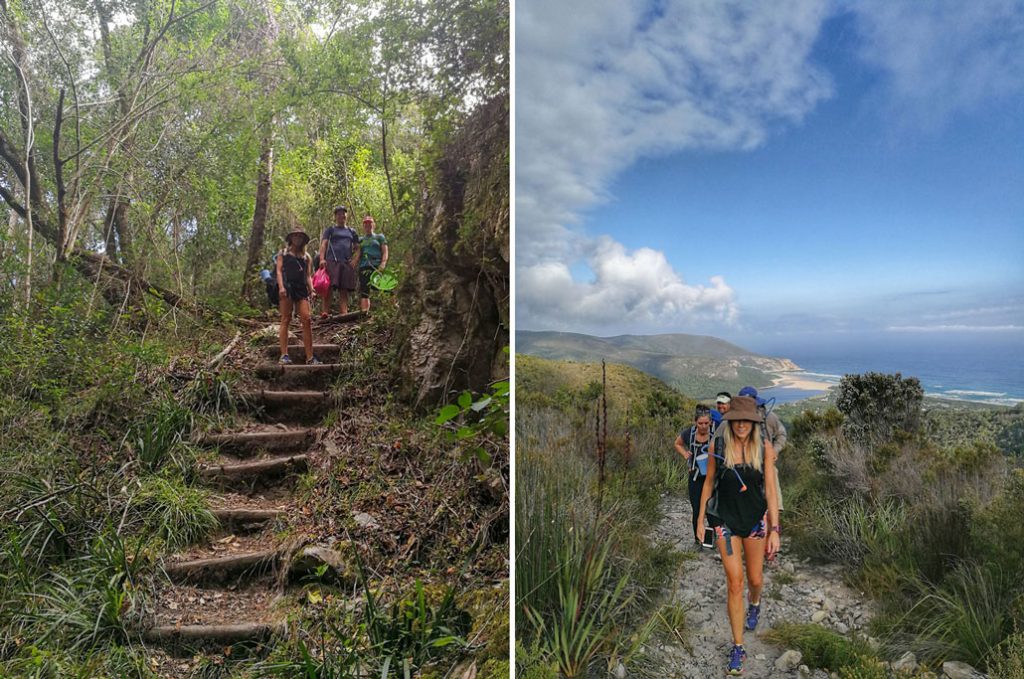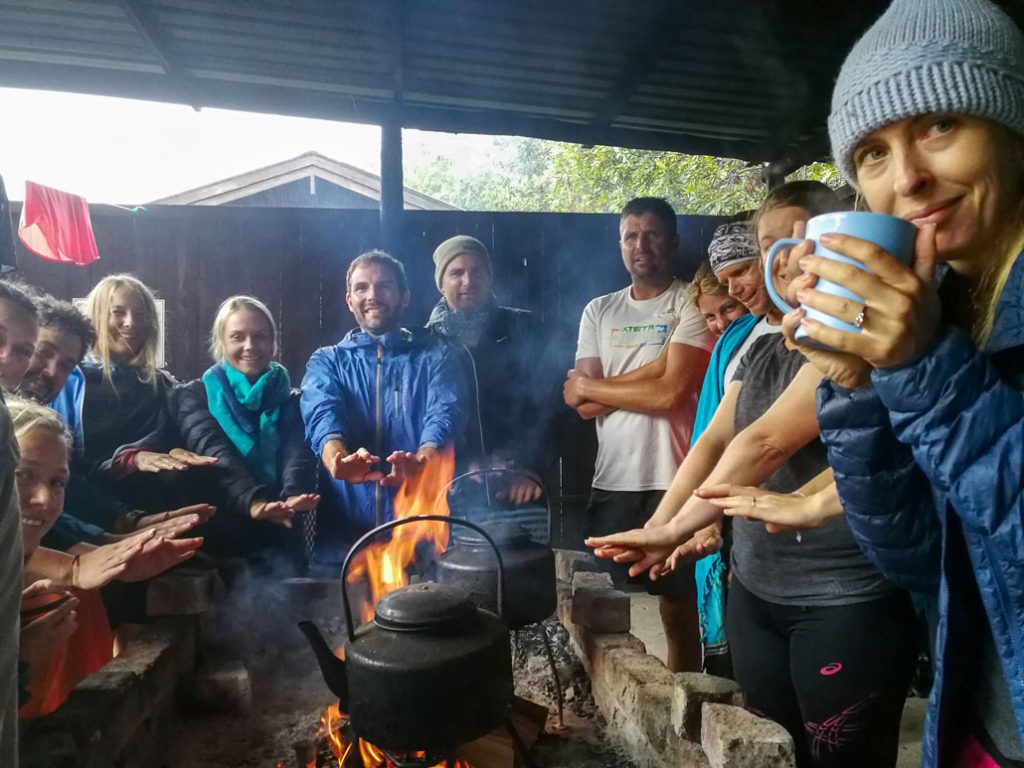
The third jewel in the crown of multi-day hiking trails in the Garden Route. The Tsitsikamma Trail is a great alternative if the Otter Trail or Outeniqua Trail isn’t available.
Beauty: 3.5/5 – Large sections of plantation roads, interspersed with stunning indigenous forests and beautiful mountain views.
Difficulty rating: 6/10 – Relatively long days, requiring moderate to good fitness.
Technical rating: Standard trail walking, interspersed with small river crossings and some beach walking on day 1.
Day 1: Nature’s valley to Kalander (3.6km)
The Tsitsikamma Trail starts at De Vaselot Caravan Park* at Nature’s Valley.
It is a fairly straight-forward hike to the first hut of the trail, Kalander, which is located just a few short kilometres (approx. 3.5km) away across the Nature’s Valley beach.
Keep an eye out for the forested entrance to Kalander Hut – the trail to the hut is found along the Eastern shores of the lagoon, where a small opening in the forested banks indicate the route towards the hut.
Because of the short distance on Day 1, it is worth being organized early on to make use of the full afternoon for beach activities – beach bats, swimming in the ocean or lagoon, or just having a sunbathe.


*For those who have completed the Otter Trail, you will recognize De Vaselot as the end point of the Otter Trail. Day 1 of the Tsitsikamma Trail will take you down memory lane, as you walk in a direct easterly direction (or in reverse) towards the last rocky outcrop of the Otter Trail.
Day 2: Kalander to Bloukrantz (16.6km)
Day 2 starts with a fairly tough incline to the top of the plateau overlooking Grootkloofbos. As marked on the map, at 16.6kms, this is supposedly the longest day of the Trail, so it is worth waking up early and giving yourself enough time to enjoy the incline and take in the views en route.

Once the plateau is reached, one takes an easy walk through thick, indigenous forest, where the calls of a multitude of birds and the soft chatter of your fellow hikers are the only accompaniment to your footfall. This section, along the Blackwood Path, gives one a taste of the best of what is still to come. After a delightful swim and pitstop at the waterfall that marks approximately 10kms, you will enter a pine plantation, and the last few kilometres are spent walking through ankle deep pine needles until you reach Bloukrantz Hut.
*Most people’s GPS devices measured this day closer to 18km, so be prepared for more than 16.6km.


It must be said that Bloukrantz Hut may very well be the highlight of the Tsitsikamma Trail. With 180° views from the front “stoep” of the Hut across the Tolbosrivier ravine, towards numerous peaks in the distance, it offers one of the most panoramic scenes of the entire trail.

Another highlight of this overnight stay is the Tolbos River directly below the hut, and the sequence of copper rockpools it offers, where one can soak your weary feet and be revived by the babble of several small waterfalls. There is no need to shower after a long soak in the cool, cola-coloured mountain water of these pools has washed the day’s sweat and grime away.


Day 3: Bloukrantz to Keurbos (13.4km)
Day 3 begins with a gentle start, an enjoyable and lengthy section through indigenous forest, that sets the tone for the rest of the day. Just before crossing the Bloukrantz river (at approximately 5.5km), a steep decline passes through a lush fern gully, where the luminous green fronds all but engulf one. It’s easy to imagine that such little-disturbed pockets of apparent Jurassic heritage have been around since time immemorial!



The Bloukrantz river typically flows wide, deep and fast, but the crossing is at a fairly narrow and shallow point of the river. The crossing is bolstered by large boulders and a handy rope strung across the river for balance. Considering the general flow of the river, it is an easy crossing, but watch out for slippery rocks which may land you in the river. This is the first of a few river crossings that follow in the days ahead.


With little altitude gain (or loss), Day 3 makes for easy walking, mostly through thickets of indigenous trees (look out for stinkwoods, red and white alders, Cape Chestnuts, ironwoods and the Outeniqua yellowwoods) or passing through patches of bright fynbos (ericas, ‘sewejaartjies’, buchu, pincushions and watsonias in abundance in summer). Colourful fungi, lichen and epiphytes (old man’s beard) adorn the untouched and ancient boulders and trees that line the way.


Day 4: Keurbos to Heuningbos (13km)
By now, you will feel well and truly ensconced in the mountains, and Day 4 offers possibly the most obvious demonstration of this: the view from Rushes Pass early on in the day, where you stand at the saddle between Klipbokkop and Elandskop. Facing north-westerly, the surrounding peaks form a bowl around the vantage point – below, the valley from where you have just come.

While one of the most breathtaking moments on the trail, it was also one of the saddest – as we realized the extent of pine infestation across the hilltops. In thickets or solitary, the silhouettes of pines stood out along every ridgeline and peak in sight.
Before crossing the Elandsbos River at roughly the 7km mark (as indicated on the map), the route is a bit unclear; it is best to ensure your group sticks together and is able to scout out the trail markers. After a relatively ‘exposed’ day on the trail, the final section of the day again passes through a thick, almost primordial forest along the side of Heuningkloof.

With several river crossings, one or two steep sections, the Rushes Pass viewpoint, and plentiful shaded riverine spots to take a spot of tea, it is worth giving yourself some extra time on Day 4, in order to fully absorb the experience. Then again, the Heuningbos Hut rivals Bloukrantz Hut for best accommodation location, and likewise offers not only an incredible view towards the mountains, but a selection of prime, deep pools a short distance away.


Day 5: Heuningbos to Sleepkloof (14km)
Arguably the toughest day, the trail steadily heads upwards on Day 5, first up Splendid Pass to Mostertshoogte, and after a descent that ends once the Witteklip River is crossed, ascending again towards Nademaalsnek. These two inclines should not be underestimated. Nor should the decline along Bosvarkpad towards Sleepkloof Hut that follows – the hut tauntingly within view a few kilometres before reaching it.


After a very exposed day on the trail, the path finally re-enters the verdant woodland – winding along parallel to the Storms River, the closed canopy of the forest presents a cool and dim green dusk. This last section also offers the final opportunity for one or two dips in the pristine mountain waters, and it is worth ducking off the trail to splash in the icy cool pools.


Despite being the hardest day, a pro tip is to combine the last day of the trail (Day 6) with this, the penultimate day. Day 5 is a relatively long and tough day; however, the last 3kms of the trail on Day 6 (from Sleepkloof Hut to the Paul Sauer bridge) is a level, easy walk that took our group approximately 40 minutes.
General tips:
- It is recommended to do this trail in warmer months (October to April), mostly in order to take full advantage of the many swimming opportunities, but also to avoid the rainy, winter season which will increase river levels and make river crossings more dangerous and difficult.
- Try and coordinate logistics of your hiking group ahead of time – for the slack packing option, it is worth meeting at De Vaselot/Nature’s Valley ahead of time, packing all the food and slack-packing items in a few cars, and then having select drivers go through to the Lottering Forestry Station to do the bag drop. We were a group of 24, in nearly half as many cars. With a bit of preparation, we could have avoided the extra 40-minute drive there and back in all the vehicles, and saved on petrol costs and toll road charge (ZAR47.00) in both directions, as well as time.
- When leaving De Vaselot Campsite, don’t go rushing towards the first trail head that you see (like we did) which will likely take you away from the beach and your first night’s accommodation, as well as delay any planned festivities. While walking on soft beach sand is never easy, the short, level walk to Kalander means that one can load up on extra luxuries for the first night – our hiking crew had wood, drinks and ice – which had all but melted by the time we rerouted ourselves!

- The key to Kalander Hut is kept in a carefully concealed safety box for which you will need a code to access the box. Request the code from MTO Forestry before arrival – between all 24 of us, we had reception and battery issues with our phones and were nearly locked out of the hut for the night.
- Start early. Always. If something goes wrong, this gives you daylight hours to manage the situation. If not, it means that you can kick back in the afternoons and enjoy the glorious hut locations to the full.
- It is worth noting that all distances measured by individuals in our group every day (using GPS devices) were longer than expected/provided for by the map. This can be psychologically tough for those who are eager to get to the overnight huts.
- In inclement weather conditions, try and keep the group together – or if it does split, ensure the different groups each have at least one map or GPS device. Importantly, always keep an eye out for escape routes (and distance markers) – of which there are several.
- If you choose slack packing, pack the essentials in the case of any eventuality: rain jacket, headlamp, hat, towel, swimming costume, first aid kit (including a space blanket), beanie, warm top or jacket, water and snacks, perhaps even a change of clothing or underwear (for the real downpours and in case you do not have access to luggage at the hut).

- After prolonged or heavy rain, the river and stream crossings may become extremely powerful and dangerous to cross. The water levels of all major rivers and other riverine tributaries should be monitored carefully after rainfall. If in any doubt, turn back and take one of the Exit routes. It will take between 6 to 24 hours for rivers to reach their normal levels once more. Do not attempt to cross any rivers when in flood.
- Do not swim in the Lottering or Kleinbos Rivers – these rivers supply water to settlements downstream.
- Hikers must pack their own food, cutlery, sleeping bags, camp stoves, pots, torches, candles, toilet paper and basic first-aid equipment. Large cast iron pots and pans are supplied at the overnight huts, but these are not always practical, especially for smaller groups of hikers.
Please note: This review was based on our experience hiking the Tsitsikamma Trail in January 2018. Much may have changed since then, including exit routes and/or rivers, streams or tributaries, as well as the length (and depth) of forested sections. Familiarize yourself with all updated, relevant safety and route information before undertaking the trail.
For bookings:
MTO Forestry (PTY) Ltd
Booking Office Number: 087 158 2110
Email address: info@mtoecotourism.co.za





Are there dates available for this December? Looks beautiful xx
Recently did the tsitsikamma 6 day hike.
The trail and huts were in very good condition!
The path is well marked and looked after!
Very impressive!!
Do the huts or cabins have woods?
Agree with everything in review. Hope the map and especially distances are updated since we also experienced frustration on it not being accurate at all so planning was difficult. But all over, a beautiful worthwhile hike and the huts’ locations are exceptional!
Hi Dania,
I’m the author of the 2025 Walks of the World Page-a-Day calendar to be published by Hachette Book Group. I’d love to include your photo of your group in the ocean at the end of the first day on the trail. You will get credit of course. All your photos of this trail are wonderful, but the only one I’m missing is one of the ocean. Please email me as soon as possible. The calendar won’t be available until July but we have to send everything to press soon. I hope to hear from you!
Hi Gail, where should I send the images to?